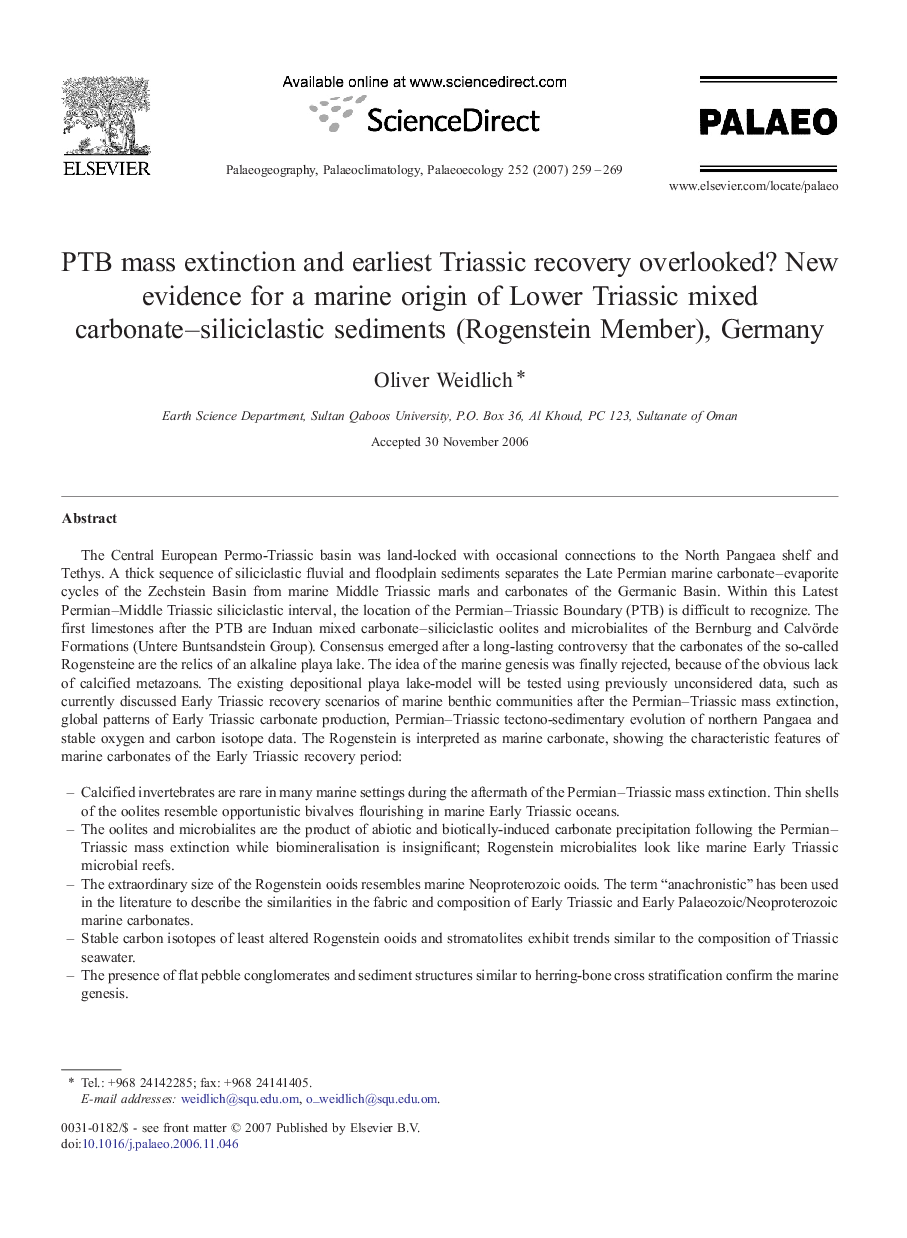| کد مقاله | کد نشریه | سال انتشار | مقاله انگلیسی | نسخه تمام متن |
|---|---|---|---|---|
| 4468827 | 1622347 | 2007 | 11 صفحه PDF | دانلود رایگان |

The Central European Permo-Triassic basin was land-locked with occasional connections to the North Pangaea shelf and Tethys. A thick sequence of siliciclastic fluvial and floodplain sediments separates the Late Permian marine carbonate–evaporite cycles of the Zechstein Basin from marine Middle Triassic marls and carbonates of the Germanic Basin. Within this Latest Permian–Middle Triassic siliciclastic interval, the location of the Permian–Triassic Boundary (PTB) is difficult to recognize. The first limestones after the PTB are Induan mixed carbonate–siliciclastic oolites and microbialites of the Bernburg and Calvörde Formations (Untere Buntsandstein Group). Consensus emerged after a long-lasting controversy that the carbonates of the so-called Rogensteine are the relics of an alkaline playa lake. The idea of the marine genesis was finally rejected, because of the obvious lack of calcified metazoans. The existing depositional playa lake-model will be tested using previously unconsidered data, such as currently discussed Early Triassic recovery scenarios of marine benthic communities after the Permian–Triassic mass extinction, global patterns of Early Triassic carbonate production, Permian–Triassic tectono-sedimentary evolution of northern Pangaea and stable oxygen and carbon isotope data. The Rogenstein is interpreted as marine carbonate, showing the characteristic features of marine carbonates of the Early Triassic recovery period:–Calcified invertebrates are rare in many marine settings during the aftermath of the Permian–Triassic mass extinction. Thin shells of the oolites resemble opportunistic bivalves flourishing in marine Early Triassic oceans.–The oolites and microbialites are the product of abiotic and biotically-induced carbonate precipitation following the Permian–Triassic mass extinction while biomineralisation is insignificant; Rogenstein microbialites look like marine Early Triassic microbial reefs.–The extraordinary size of the Rogenstein ooids resembles marine Neoproterozoic ooids. The term “anachronistic” has been used in the literature to describe the similarities in the fabric and composition of Early Triassic and Early Palaeozoic/Neoproterozoic marine carbonates.–Stable carbon isotopes of least altered Rogenstein ooids and stromatolites exhibit trends similar to the composition of Triassic seawater.–The presence of flat pebble conglomerates and sediment structures similar to herring-bone cross stratification confirm the marine genesis.I propose that cool seawater transgressed during a global rise of Late Permian–Early Triassic base-level from the Barents shelf southward along reactivated extensional graben structures and flooded the Central European Permo-Triassic basin. There, the extremely hot and arid climate of the megacontinent Pangaea caused increased evaporation of seawater and subsequent supersaturation with respect to calcium carbonate. Insignificant biomineralisation and high water energy in the shallow sea give rise to largely abiotic and biotically-induced carbonate precipitation which resembles lake sediments at first sight. Benthic tropical carbonate production started with the next transgression during the Röt Formation, leading to the sedimentation of marls and limestones during the Spathian (late Olenekian).
Journal: Palaeogeography, Palaeoclimatology, Palaeoecology - Volume 252, Issues 1–2, 20 August 2007, Pages 259–269